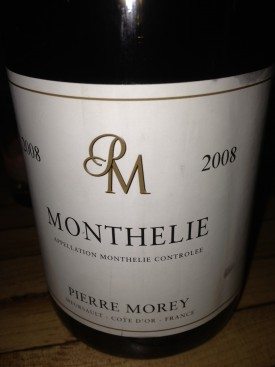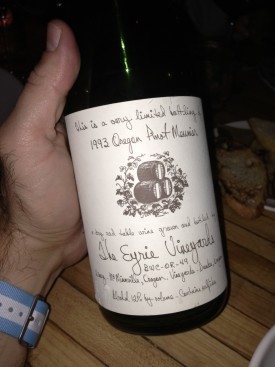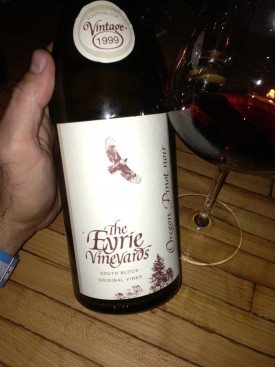The ability to relish bottles with anything from deep mastery to rookie wine knowledge lends an egalitarian charm to wine appreciation. Nevertheless, when you learn a bunch about wine you innately understand there is always so much more to know about it. Infinite opportunities for discovery drive nagging self doubt and a maniacal pursuit of knowledge that are part and parcel of the dedicated wino profile. Like anything else in life we value, accepting that someone else will always know or have more than you is good Buddha practice.
 With great anticipation of new learning and a modicum of Buddha-controlled self doubt I sat down to dinner last week with Levi Dalton, who I first met virtually through his blog “So You Want To Be A Sommelier“. Levi’s creative writing matches a pinnacle resume in the restaurant wine trade as sommelier/wine director at Alto, Masa, Daniel, Convivio, Federalist, Boulud Sud and more. I became hooked on his blog and was further reeled in by his powerful series of “I’ll Drink To That” podcasts; interviews with everyone that counts in the wine business, or as Levi admitted to me, “the right people-not the ones pitched every day by the wine industry’s PR machine.” Reading and listening to Levi on wine is rich, but having him orchestrate an evening of wines was something still missing in my life of wine. On a self imposed hiatus from the wine service trade, and now writing for Eater.com in NY as wine editor, my only chance was to invite him to dinner. Another savvy NY drinker I have been virtually connected with for a while but never met in person, photographer Greg, joined us too and contributed many of the photos for this post.
With great anticipation of new learning and a modicum of Buddha-controlled self doubt I sat down to dinner last week with Levi Dalton, who I first met virtually through his blog “So You Want To Be A Sommelier“. Levi’s creative writing matches a pinnacle resume in the restaurant wine trade as sommelier/wine director at Alto, Masa, Daniel, Convivio, Federalist, Boulud Sud and more. I became hooked on his blog and was further reeled in by his powerful series of “I’ll Drink To That” podcasts; interviews with everyone that counts in the wine business, or as Levi admitted to me, “the right people-not the ones pitched every day by the wine industry’s PR machine.” Reading and listening to Levi on wine is rich, but having him orchestrate an evening of wines was something still missing in my life of wine. On a self imposed hiatus from the wine service trade, and now writing for Eater.com in NY as wine editor, my only chance was to invite him to dinner. Another savvy NY drinker I have been virtually connected with for a while but never met in person, photographer Greg, joined us too and contributed many of the photos for this post.
We drank very well on this particular NYC evening off the Saxon+Parole wine list (mainly because I turned it over to Levi). It was fun for me to watch his flow and orchestration of selections, one at a time. Australian Riesling to start? Wouldn’t have been my choice, but the 2012 Grosset Springvale was magically crisp with verve, citric, and floral aspects for a perfect pairing with our oysters. Lesson 1: Stop dismissing Australia or other entire sections of a wine list just because the region has fallen out of favor or your focus has shifted. Tunnel vision makes it too easy to overlook venerable regional producers like Grosset. I guess when you are elbow deep in classic wine cellars as Levi has been, unlimited peripheral vision forces you to put everything into play.
 There is value from great producers in Burgundy, and I wish I knew more about that. It helps remembering that Pierre Morey made wine at Domaine Leflaive, and left to focus on the winery he founded in 1971. I would have overlooked his 2008 red from the village of Monthelie that you can buy at retail for $30. Levi eased into our red wines with it, and the wonderful earthy aromas mixed with bright Pinot fruit in a wine of great freshness and velvet feel. It reminded me of the time I discovered Raquillet’s amazing value priced red wines from Mercurey that I continue to rely on today for everyday Burgundy drinking. Lesson 2: stay in the hunt for value in Burgundy.
There is value from great producers in Burgundy, and I wish I knew more about that. It helps remembering that Pierre Morey made wine at Domaine Leflaive, and left to focus on the winery he founded in 1971. I would have overlooked his 2008 red from the village of Monthelie that you can buy at retail for $30. Levi eased into our red wines with it, and the wonderful earthy aromas mixed with bright Pinot fruit in a wine of great freshness and velvet feel. It reminded me of the time I discovered Raquillet’s amazing value priced red wines from Mercurey that I continue to rely on today for everyday Burgundy drinking. Lesson 2: stay in the hunt for value in Burgundy.
Driving for an even more interesting Pinot experience, 1999 Eyrie Vineyards Pinot Noir caught Levi’s eye. I am still not sure, but I suspect he knew it was the unique South Block Reserve wine that the late David Lett cherished and became famous for in the late 1970’s after winning competitions in France. Following that recognition, these wines were not bottled for immediate release and Lett simply held them in Eyrie’s cellars. Lett’s son is now slowly releasing some of these legendary wines. I have no idea if this 1999 just hit the market, but its earthy, mushroom, dusty fruit magic is available today if you want something really special and are willing to spend $235 on old Eyrie Vineyard Pinot Noir.
And without a suitably more intense Syrah on the list as our next step up, Levi conversed his way off the list and into the cellar to land the 1993 Eyrie Pinot Meunier that you can still pick up at Chambers Street now for $190; another slice of Oregon’s wine history exposed. Levi noted its reductive quality, but I dwelled on the advanced sweet fruit, silky mouthfeel, and background hints of licorice. Lesson 3: Stop forgetting to ask the sommelier if there is anything on or off the list that he/she feels I should know about.
a suitably more intense Syrah on the list as our next step up, Levi conversed his way off the list and into the cellar to land the 1993 Eyrie Pinot Meunier that you can still pick up at Chambers Street now for $190; another slice of Oregon’s wine history exposed. Levi noted its reductive quality, but I dwelled on the advanced sweet fruit, silky mouthfeel, and background hints of licorice. Lesson 3: Stop forgetting to ask the sommelier if there is anything on or off the list that he/she feels I should know about.
I wanted to put Levi in my pocket and take him with me. I “want to be with a sommelier” like him every time I sit down at restaurants around the world. While none of the three lessons were new to me, Levi’s open discernment combined with the wine experience he extracted from Saxon+Parole’s inventory as powerful reminders. The three disciplines flushed out value, discovery, and legend. Thanks, Levi.

